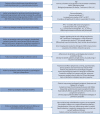European Respiratory Society statement on long COVID follow-up
- PMID: 35144991
- PMCID: PMC9349784
- DOI: 10.1183/13993003.02174-2021
European Respiratory Society statement on long COVID follow-up
Abstract
Patients diagnosed with coronavirus disease 2019 (COVID-19) associated with severe acute respiratory syndrome coronavirus 2 (SARS-CoV-2) infection frequently experience symptom burden post-acute infection or post-hospitalisation. We aimed to identify optimal strategies for follow-up care that may positively impact the patient's quality of life (QoL). A European Respiratory Society (ERS) Task Force convened and prioritised eight clinical questions. A targeted search of the literature defined the timeline of "long COVID" as 1-6 months post-infection and identified clinical evidence in the follow-up of patients. Studies meeting the inclusion criteria report an association of characteristics of acute infection with persistent symptoms, thromboembolic events in the follow-up period, and evaluations of pulmonary physiology and imaging. Importantly, this statement reviews QoL consequences, symptom burden, disability and home care follow-up. Overall, the evidence for follow-up care for patients with long COVID is limited.
Copyright ©The authors 2022.
Conflict of interest statement
Conflict of interest: K.M. Antoniou declares consulting fees, payment or honoraria for lectures, presentations, speakers bureaus, manuscript writing or educational events and support for attending meetings and/or travel from Boehringer Ingelheim and Roche, in the 36 months prior to manuscript submission; and an unpaid role as Secretary of the European Respiratory Society Interstitial Lung Diseases Assembly. E. Vasarmidi declares no competing interests. A-M. Russell declares payment or honoraria for lectures, presentations, speakers bureaus, manuscript writing or educational events, and support for attending meetings and/or travel from Boehringer Ingelheim, Roche and the Irish Lung Fibrosis Association, in the 36 months prior to manuscript submission. C. Andrejak declares an honorarium for a lecture on COVID-19 for “Avancées en Pneumologie” (Actuality on Respiratory Disease) funded by AstraZeneca; support for attending meetings and/or travel from Aeris Medical, SOS Oxygène and Vitalaire; and participation on an advisory board on the French COVID Cohort, an institutional epidemiological study, in the 36 months prior to manuscript submission; in addition, they are a member of the French Public Health Council (COVID treatment group) and participate on an advisory board for an prospective cohort study on COVID sequelae (SEQ COV). B. Crestani reports grants to their institution from Boehringer Ingelheim and Roche; consulting fees from Apellis, Boehringer Ingelheim, Roche and Sanofi; payment or honoraria for lectures, presentations, speakers bureaus, manuscript writing or educational events, and support for attending meetings and/or travel from Boehringer Ingelheim, Roche, Novartis and Sanofi; and paid participation on a data safety monitoring board or advisory board for Apellis, Boehringer Ingelheim, Roche and Sanofi, in the 36 months prior to manuscript submission. M. Delcroix declares no competing interests. A.T. Dinh-Xuan declares payment or honoraria for lectures, presentations or educational events from Chiesi, Circassia, GlaxoSmithKline, Novartis and Sanofi, in the 36 months prior to manuscript submission. V. Poletti declares no competing interests. N. Sverzellati declares payment or honoraria for lectures, presentations, speakers bureaus, manuscript writing or educational events from Boehringer Ingelheim, Roche and Chiesi; and support for attending meetings and/or travel from Boehringer Ingelheim, in the 36 months prior to manuscript submission. M. Vitacca declares no competing interests. M. Witzenrath declares grant funding from Deutsche Forschungsgemeinschaft, Bundesministerium für Bildung und Forschung, Deutsche Gesellschaft für Pneumologie, European Respiratory Society, Marie Curie Foundation, Else Kröner Fresenius Stiftung, Capnetz Stiftung, International Max Planck Research School, Quark Pharma, Takeda Pharma, Noxxon, Pantherna, Silence Therapeutics, Vaxxilon, Actelion, Bayer Health Care, Biotest and Boehringer Ingelheim; consulting fees from Noxxon, Pantherna, Silence Therapeutics, Vaxxilon, Aptarion, GlaxoSmithKline, Sinoxa and Biotest; payment or honoraria for lectures, presentations, speakers bureaus, manuscript writing or educational events from AstraZeneca, Berlin-Chemie, Chiesi, Novartis, Teva, Actelion, Boehringer Ingelheim, GlaxoSmithKline, Biotest and Bayer Health Care, in the 36 months prior to manuscript submission; and three patents relating to modulation of immune response in acute lung injury, inhibition of Ang-2 expression and treatment of SARS-CoV-2-infected lung cells, respectively. T. Tonia acts as a European Respiratory Society Methodologist. A. Spanevello declares payment or honoraria for lectures, presentations, speakers bureaus, manuscript writing or educational events, and support for attending meetings and/or travel from Merck Sharp & Dohme, GlaxoSmithKline, AstraZeneca, Menarini, Guidotti and Chiesi, in the 36 months prior to manuscript submission.
Figures

References
-
- Spruit MA, Holland AE, Singh SJ, et al. . COVID-19: interim guidance on rehabilitation in the hospital and post-hospital phase from a European Respiratory Society- and American Thoracic Society-coordinated international task force. Eur Respir J 2020; 56: 2002197. doi:10.1183/13993003.02197-2020 - DOI - PMC - PubMed
-
- World Health Organization . WHO coronavirus (COVID-19) dashboard. 2022. https://covid19.who.int Date last accessed: 4 May 2022.
Publication types
MeSH terms
Grants and funding
LinkOut - more resources
Full Text Sources
Medical
Miscellaneous
